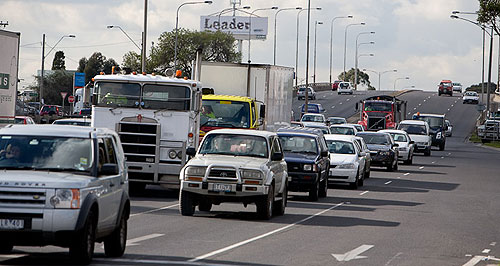Make / Model Search
News - General News - TechnologyNew tech enables road-funding trialCharge up: Transurban chief executive officer Scott Charlton said his company will conduct a trial of volunteers in Melbourne to determine the best model of road charging system Transurban to test driver attitudes to new ways of paying for roads14 May 2015 By IAN PORTER A NEW wave of technology, including intelligent transport systems, has arrived just in time to help governments replace their ageing road funding programs with new and fairer systems, according to a leading road operator. The swing towards more efficient vehicles has dramatically reduced the fuel excise collected by the federal government as a proportion of general revenue and this is putting pressure on infrastructure spending, Transurban chief executive officer Scott Charlton believes. The desire to find another way of paying for roads and infrastructure was a factor behind Transurban’s plan to test three different road pricing models in a trial program due to start in the second half of the year, Mr Charlton said. “Excise as proportion of GDP (gross domestic product) has fallen from 1.8 per cent 10 years ago to just under 1.2 per cent today, and every 20 year-old vehicle taken off the road and replaced with a late model car, we expect to lose $350 in fuel excise per annum,” he told the Australian Intelligent Transport Systems (ITS) Summit in Melbourne this week. This had led to a $7 billion shortfall between excise revenue and the amount spent by the federal government on infrastructure, Mr Charlton said. “State governments on the other hand have to drive up fixed charges on registration, licence fees and stamp duty on vehicles to cover the shortfall. “In the past 15 years, revenues from stamp duty and drivers’ licences have doubled and revenue from vehicle registrations have risen 126 per cent.”“The funding system has outlived its usefulness. It’s not transparent and it’s inherently unfair. “The driver of a late model fuel-efficient car pays far less in fuel excise than the driver of an older model despite having similar impact on congestion and similar impact on infrastructure.” These trends were recognised in a Productivity Commission report earlier this year that recommended a new system of road usage pricing be adopted. Mr Charlton said several systems of charging for road use were in use around the world in places such as Singapore, Europe, some American states and London. “The philosophy behind Europe’s heavy vehicle charging system is about fairness and ensuring those who use the road make a fair contribution. The London congestion charge offers transparency around how funds are spent.” Mr Charlton said these examples had components pointing to a fair and sustainable road charging system, although he warned that there would be a backlash from the public if the new system was not well understood. In order to find out what type of road charging system Australian drivers would prefer, Mr Charlton said Transurban was preparing to run a trial using volunteer drivers from Melbourne. The range of devices now available for logging onboard data and transmitting it to a head office would make running the trial relatively easy. The trial will not be confined to Transurban’s toll roads, which are all fitted with sensors. It will cover all roads in Melbourne and give an accurate picture of road usage by the volunteers. “We have chosen to trial three user pays models in our study, a distance-based charge, a price-per-trip charge and an annual access charge,” Mr Charlton said. The trial will start in the middle of the year with 100 drivers to gather some preliminary data, which will be used to set up the main trial, which will involve 1200 volunteers. Mr Charlton said the devices fitted to the cars would vary, according to the level of technology in each car. Given that 60 per cent of vehicles on the roads have an onboard diagnostic port, it was expected that most devices would be plugged into that. “We have pretty good models for modeling congestion and traffic on the network, but the study will give us what no modeling can do, and that’s what Australians think about road user pricing models, because unless Australians are willing to accept the point, it doesn’t matter how good the science is. “Let’s be clear – the only way we can avoid joining the global gridlock is to look beyond our roads to the wider network . “We need to find a way to encourage considered and well informed discussion within the wider community. And we believe our road pricing study will provide a pathway to having that discussion. “We need a funding system that is fair and sustainable that is built in the principle that those who use it pay. “Australians agree in principle. We have lots of good research where they agree with the principle and now we are putting it to the test, what they actually think when they have to pay.”  Read more |
Click to shareGeneral News articlesResearch General News Motor industry news |










Facebook Twitter Instagram